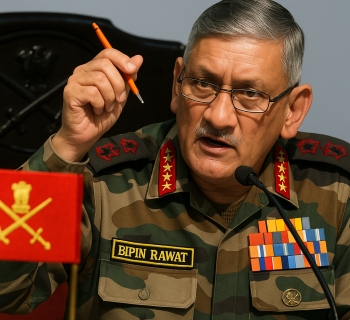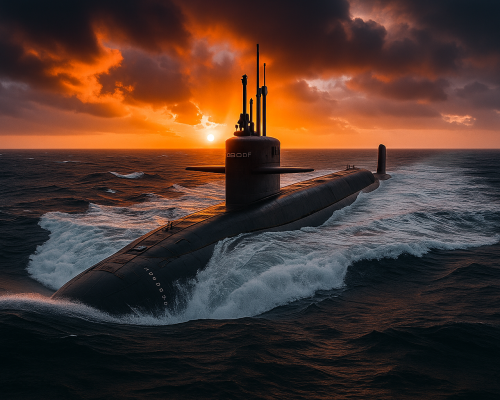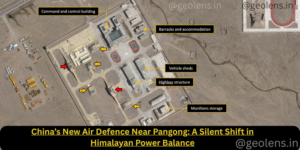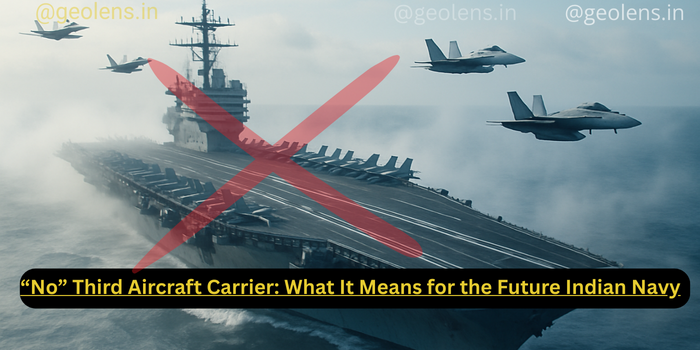Table of Contents
The ocean is controlled by those who possess modernized weapons, maneuverability, stealth, and speed.
Pratik Kondawale Tweet
Introduction – Official Government Statement
In early 2025, the Government of India made it official: India will not pursue the operation of three aircraft carriers simultaneously. Instead, the focus will shift toward strengthening undersea capabilities and other modern naval assets. This decision came after months of strategic evaluation, budgeting reviews, and technological feasibility assessments.
Sources within the Ministry of Defence confirmed that while India will maintain a two-carrier force, the long-anticipated third aircraft carrier—once envisioned as a nuclear-powered supercarrier—has been effectively shelved. This change marks a significant shift in India’s naval doctrine and strategic priorities.
The Original Plan: Third Aircraft Carrier
For over a decade, Indian naval planners advocated a Third Aircraft Carrier model:
INS Vikramaditya to operate on the western front (Arabian Sea)
INS Vikrant to cover the eastern seaboard (Bay of Bengal)
INS Vishal as a strategic reserve or global deployment carrier
The third aircraft carrier, INS Vishal, was to be a next-generation vessel featuring advanced systems like CATOBAR (Catapult Assisted Take-Off but Arrested Recovery), possibly nuclear propulsion, and an expanded air wing including drones and early warning aircraft.
This model was meant to ensure that two aircraft carriers would always be available for deployment while one underwent maintenance, thereby providing continuous naval dominance across the Indian Ocean Region (IOR).
Why India Changed the Course for Third Aircraft Carrier

Statement by Late CDS Gen. Bipin Rawat
Former Chief of Defence Staff, Gen. Sir Bipin Rawat, had voiced skepticism about the need for three carriers. He famously described them as “sitting ducks“, vulnerable to modern anti-ship missiles and satellite tracking systems. He stressed that the Navy’s demand for a third carrier should only be considered after evaluating the operational performance of the first indigenous carrier, INS Vikrant.
Rising Costs & Budgetary Realities
Strategic Shift to Submarines
India is now prioritizing undersea warfare capabilities, including:
- Project 75 Alpha – Indigenous nuclear-powered attack submarines (SSNs)
- Expansion of Kalvari-class diesel-electric submarines
- Improving anti-submarine warfare (ASW) assets and technology
Submarines offer stealth, survivability, and strategic deterrence—qualities more relevant in today’s high-tech, contested maritime zones.
Technology & Infrastructure Limitations
Building a nuclear-powered, CATOBAR carrier like INS Vishal would require massive technological advancements, EMALS systems, and upgrades to shipbuilding facilities. India currently lacks this infrastructure.
What's the Plan Now | Way Forward
India’s current plan focuses on maintaining a two-carrier fleet:
INS Vikramaditya (Russian origin, operational since 2013)
INS Vikrant (first indigenous carrier, under operationalization)
However, sources in the Defence establishment have confirmed that INS Vikramaditya will be phased out in the next 10–12 years. Plans are underway to construct a second indigenous carrier that will replace Vikramaditya—not add to the fleet.
In simpler words: The Navy will still build a new carrier, but only to replace the aging Vikramaditya. So, India will continue to operate just two carriers at any time, not three.
The upcoming carrier (IAC-2) may be a repeat of the Vikrant-class to avoid technological delays and cost escalation.
Aircraft Carrier vs Submarine: A New Doctrine
India is now leaning toward a doctrine of sea denial and stealth power, rather than power projection via large surface assets.
| Feature / Capability | Aircraft Carriers | Submarines (SSKs/SSNs/SSBNs) |
|---|---|---|
| Primary Role | Power projection, air dominance at sea | Sea denial, stealth strike, deterrence |
| Visibility | High – large and easy to detect | Low – stealthy and difficult to detect |
| Vulnerability | Susceptible to long-range anti-ship missiles and surveillance | Hard to detect, can strike silently |
| Operational Range | Global (especially nuclear carriers), but depends on support fleet | Extremely long (esp. nuclear SSNs/SSBNs) |
| Construction Cost | ₹45,000–50,000 crore (~$6–8B) per carrier + support fleet | ₹6,000–15,000 crore (~$800M–$2B) per sub |
| Time to Build | 10–15 years | 5–8 years (nuclear takes longer) |
| Deterrence Factor | Visible deterrence – shows presence | Strategic deterrence – hidden & deadly |
| Flexibility in conflict | Ideal in high-intensity wars, needs airspace freedom | Useful in both peacetime surveillance and wartime offensive/defensive roles |
| Crew & Manpower | 1,500–2,000 per carrier group | 80–120 per submarine |
| Current Indian Assets | INS Vikramaditya, INS Vikrant | Kalvari-class (SSKs), Arihant-class (SSBNs), SSN project under development |
India’s shift reflects an understanding that future naval warfare may be less about visible dominance and more about invisible lethality.

Comparison Chart – Naval Power: India vs China vs USA vs Russia
| Country | Aircraft Carriers | Nuclear Subs | Conventional Subs | Naval Strategy |
| India | 2 (1 planned) | 1 SSBN (6 SSNs planned) | 14 SSKs | Regional dominance, stealth focus |
| China | 3 (3 more planned) | 12 SSNs, 6 SSBNs | 60+ SSKs | Blue-water expansion, carrier-centric |
| USA | 11 (nuclear) | 70+ SSNs, 14 SSBNs | None (all nuclear) | Global domination, full carrier strike groups |
| Russia | 1 (Admiral Kuznetsov) | 30+ nuclear subs | 20+ SSKs | Coastal defense & Arctic power |
Also read about – “We should have our own jet engines for Made in India fighter jets”: PM Modi in Independence Day 2025
Challenges for the Indian Navy
- Budget Allocation – Competing demands from Army and Air Force.
- Aging Fleet – Many warships and submarines need replacement.
- Infrastructure – Limited capacity to build large warships.
- Technology Gaps – EMALS, nuclear propulsion, advanced radar systems still underdeveloped.
- Logistics – Maintaining a fleet across two oceanic fronts with limited bases.
- China’s Maritime Rise – Rapid expansion of PLA Navy threatens India’s regional dominance.
Conclusion
India’s decision to drop the third aircraft carrier is a strategic recalibration, not a retreat. It reflects a pragmatic assessment of budget, technology, and evolving threats. Instead of investing in large, expensive surface platforms, India is betting on stealth, flexibility, and undersea strength.
The future Indian Navy will likely be a leaner, smarter force—backed by two carriers, a fleet of nuclear and conventional submarines, and advanced surveillance and strike capabilities. While the aircraft carrier remains a symbol of naval power, India is now defining power through stealth and strategic deterrence, not just visible might.
No Third Aircraft Carrier Frequently Asked Questions (FAQ)
Q1: Why did India decide not to pursue a third aircraft carrier?
India chose not to operate a third aircraft carrier due to a combination of strategic, technological, and budgetary factors. The government wants to focus more on stealth-based platforms like submarines, which offer greater survivability and deterrence in modern naval warfare. High costs, emerging missile threats, and infrastructure limitations also influenced the decision.
Q2: Is India completely canceling the third aircraft carrier (INS Vishal)?
Not entirely. India is not abandoning carrier operations, but reframing the third carrier as a replacement, not an addition. The upcoming Indigenous Aircraft Carrier-2 (IAC-2) will eventually replace INS Vikramaditya, which is expected to retire in the next 10–12 years.
Q3: What did General Bipin Rawat mean by calling aircraft carriers “sitting ducks”?
Former CDS Gen. Bipin Rawat warned that aircraft carriers are large and easily detectable, making them vulnerable to modern anti-ship missiles and space-based surveillance. He advocated for investing in undersea capabilities and prioritizing results from INS Vikrant before committing to another carrier.
Q4: What is India focusing on instead of a third carrier?
India is investing in:\n- Nuclear-powered attack submarines (SSNs) under Project 75 Alpha\n- Expansion of the Kalvari-class submarines\n- Improved anti-submarine warfare capabilities and drone surveillance\n- Modern destroyers, frigates, and maritime strike aircraft
Q5: Will India’s naval power weaken without a third carrier?
Not necessarily. While aircraft carriers are visible symbols of power, India’s new strategy prioritizes stealth, strategic deterrence, and underwater dominance, which are more effective in high-tech conflict scenarios. The two-carrier model is still considered sufficient for India’s dual-front maritime posture.
Q6: How does India compare with China and the US in naval strength?
India: 2 carriers (1 more planned), 14 conventional subs, 1 SSBN, 6 SSNs in development
China: 3 carriers (3 more coming), over 70 submarines
USA: 11 nuclear-powered carriers, unmatched global reach
While India lags in numbers, its focus is on quality regional deterrence, not global expeditionary power like the US or China.
Q7: What happens to INS Vikramaditya in the future?
According to defence sources, INS Vikramaditya will be phased out within the next 10–12 years due to age and maintenance costs. It will be replaced by a newer indigenous aircraft carrier (IAC-2), maintaining India’s two-carrier operational capability.
Q8: Is India moving away from carrier-based naval strategy altogether?
No, India still values carriers but is no longer following a carrier-heavy doctrine. The strategy is evolving to balance surface power with undersea lethality, particularly in response to China’s aggressive expansion and modern warfare trends.
No Third Aircraft Carrier People Also Ask (PPA)
- Why did India drop the plan for a third aircraft carrier?
Because of extremely high costs, technological limitations, and the growing vulnerability of large carriers to long-range precision missiles and satellite tracking. India now prefers more survivable, stealth-driven platforms. - What is India focusing on instead of a third aircraft carrier?
India is prioritizing nuclear-powered attack submarines, expansion of diesel-electric submarines, stronger anti-submarine warfare, and advanced maritime surveillance to counter modern threats more effectively. - Is the INS Vishal project cancelled?
Not completely. The option of building a new carrier remains, but only as a replacement for INS Vikramaditya — not as a third addition. India will stick to a two-carrier strategy for operational practicality. - Why did Gen. Bipin Rawat call aircraft carriers “sitting ducks”?
He warned that carriers are large, easy-to-spot targets for hypersonic missiles and space-based tracking systems — making them highly vulnerable in modern combat environments. - Will India’s naval strength reduce without a third aircraft carrier?
No. India is shifting to a smarter doctrine of stealth and sea denial, where submarines provide more realistic deterrence and survivability than massive surface strike groups. - What are the biggest challenges India faces in operating multiple carriers?
Aging fleet, limited budget, lack of advanced shipyard infrastructure, costly technology like EMALS and nuclear propulsion, and manpower demands of carrier battle groups. - What is India’s future aircraft carrier plan?
A new Indigenous Aircraft Carrier-2 (IAC-2) is planned to replace INS Vikramaditya within 10–12 years. This keeps India operating two active carriers for both seaboards without financial overstretch. - Why are submarines considered a better option for India’s naval strategy?
Submarines offer stealth, strike capability, and strategic deterrence — making them harder to detect and ideal for contested zones in the Indian Ocean against rivals like China.
|The GeoLens – Indian Defense & Global Affairs
India’s 5th Generation Fighter Jet AMCA: Where We Stand, Challanges, & Way Ahead

Pratik Kondawale
Strategist | Indian Defence & Global Affairs
Founder of GeoLens.in, Pratik writes in-depth analysis on India’s defence strategy, military tech, and global power shifts delivering sharp insights through an Indian lens.

Tejas Crash at Dubai Air Show 2025 — A Tragedy, A Lesson, and A Call for Reform
The Tejas crash at the Dubai Air Show turned a moment of national pride into sudden heartbreak when Wing Commander Syal lost his life. This article unpacks the events of that day, explains why the Tejas crash matters for India’s defense readiness, and outlines the practical lessons and reforms needed to ensure the program recovers stronger. It also honors the pilot’s sacrifice and shows how the Tejas crash can become a catalyst for accountability, safer engineering, and faster delivery of operational jets.

Bangladesh EX-PM Sheikh Hasina Death Sentenced: Turmoil in Bangladesh and Rewired South Asian Politics
The Sheikh Hasina death sentenced verdict has detonated one of the most explosive political crises in Bangladesh’s modern history. Delivered in absentia by the International Crimes Tribunal, the ruling blames the former prime minister for orchestrating widespread state violence during the 2024 student protests. The decision has dismantled the Awami League’s long-standing dominance, pushed Bangladesh into a volatile power vacuum, and placed India in the middle of a diplomatic standoff. As questions about justice, political motivation, and regional stability collide, the fallout of this verdict is reshaping South Asian geopolitics in real time.

China with New Air Defence Near Pangong: A Silent Shift in Himalayan Power Balance
China’s new air defence near Pangong marks a major strategic escalation in the Himalayas. Satellite imagery reveals advanced HQ-9 missile systems, radar units, and fortified shelters aimed at asserting Chinese air dominance over eastern Ladakh. This development not only alters the regional military balance but also raises critical questions about India’s preparedness, response strategy, and the long-term implications for border security and geopolitical stability in South Asia.

Afghanistan Pakistan War 2025: Causes, Escalation, and India’s Strategic Advantage
The recent Afghanistan Pakistan war marks a dangerous escalation from border tensions to open state-level confrontation. What began with Pakistani airstrikes inside Afghan territory quickly spiraled into fierce Afghan retaliation, signaling Kabul’s newfound military assertiveness. This conflict exposes Pakistan’s growing vulnerabilities—diplomatic isolation, two-front pressure, and internal instability—while reshaping regional power equations.
For India, the turmoil presents both strategic opportunity and cautious optimism. A distracted Pakistan allows New Delhi to strengthen its influence in Afghanistan and consolidate regional partnerships. Meanwhile, the muted response from Gulf powers like Saudi Arabia and Qatar underscores Islamabad’s weakening alliances. As the Durand Line dispute reignites and media warfare intensifies, the Afghanistan Pakistan war stands as a defining moment in South Asia’s evolving geopolitical order—one that could tilt the balance of power in India’s favor.

Gen Z Protests in Nepal: From Nepo Kids, Corruption, Social Media Ban to Western Interference—What It Means for India
The Gen Z Protests in Nepal go beyond anger over a social media ban—they represent decades of frustration with corruption, nepotism, unemployment, and poor governance. Fueled by rising inflation, scams, and lack of opportunities, Nepal’s youth have taken to the streets demanding accountability.
But behind the scenes, questions of Western interference and U.S. attempts to reshape the world order add a deeper geopolitical layer. For India, Nepal’s instability is more than a neighbor’s problem—it carries direct implications for security, migration, and regional power balance.

Punjab Flood 2025: Lessons from 1988 & Why Punjab Remains Vulnerable
Punjab Flood 2025 has left a devastating mark across the state, with 1,400 villages submerged, 350,000 people affected, and 149,000 hectares of farmland under water. As rivers overflowed and dams released excess water, the disaster exposed Punjab’s recurring flood challenges and the urgent need for long-term resilience.


6 thoughts on ““No” Third Aircraft Carrier: What It Means for the Future Indian Navy”